Two-Photon Polymerized Poly(2-Ethyl-2-Oxazoline) Hydrogel 3D Microstructures with Tunable Mechanical Properties for Tissue Engineering
Abstract
1. Introduction
2. Results and Discussion
2.1. Synthesis and Structural Characterization of Poly(2-Oxazoline) Macromonomers
2.2. Swelling Behavior, Mechanical Properties, and 2PP Structuring of Different POx Systems
3. Materials and Methods
3.1. Chemicals and Instrumentation
3.2. UV Curing and 2PP Structuring of 3D Scaffolds
3.3. Synthesis of PEtOx-A by CROP
3.3.1. General Synthesis Procedure
3.3.2. Synthesis of PEtOx-A DP10
3.4. Synthesis of PEtOx-DA by CROP and Photoinitiator BA740
3.5. Mechanical Measurements, Imaging, and Evaluation
4. Conclusions
Author Contributions
Funding
Conflicts of Interest
Appendix A
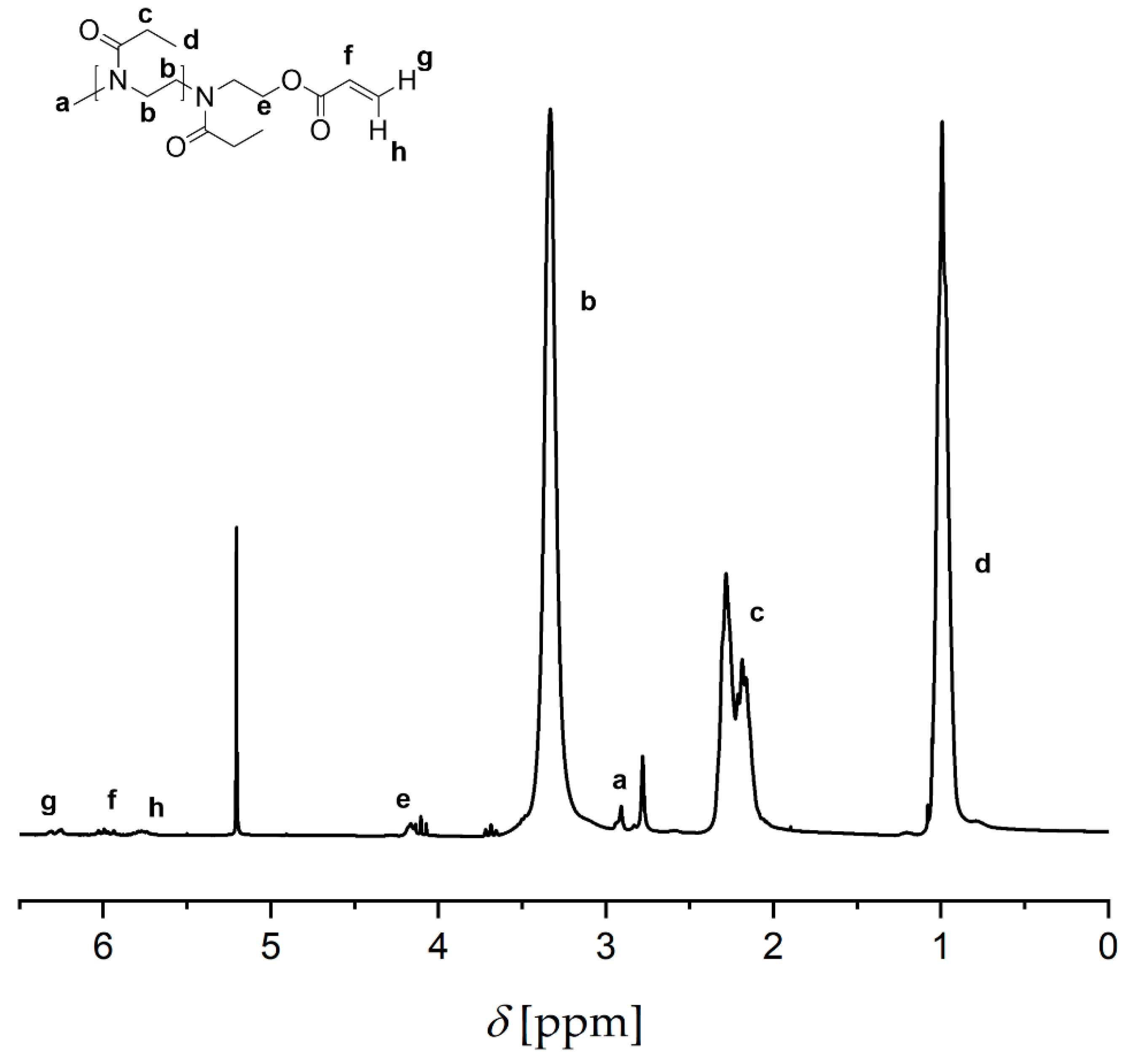
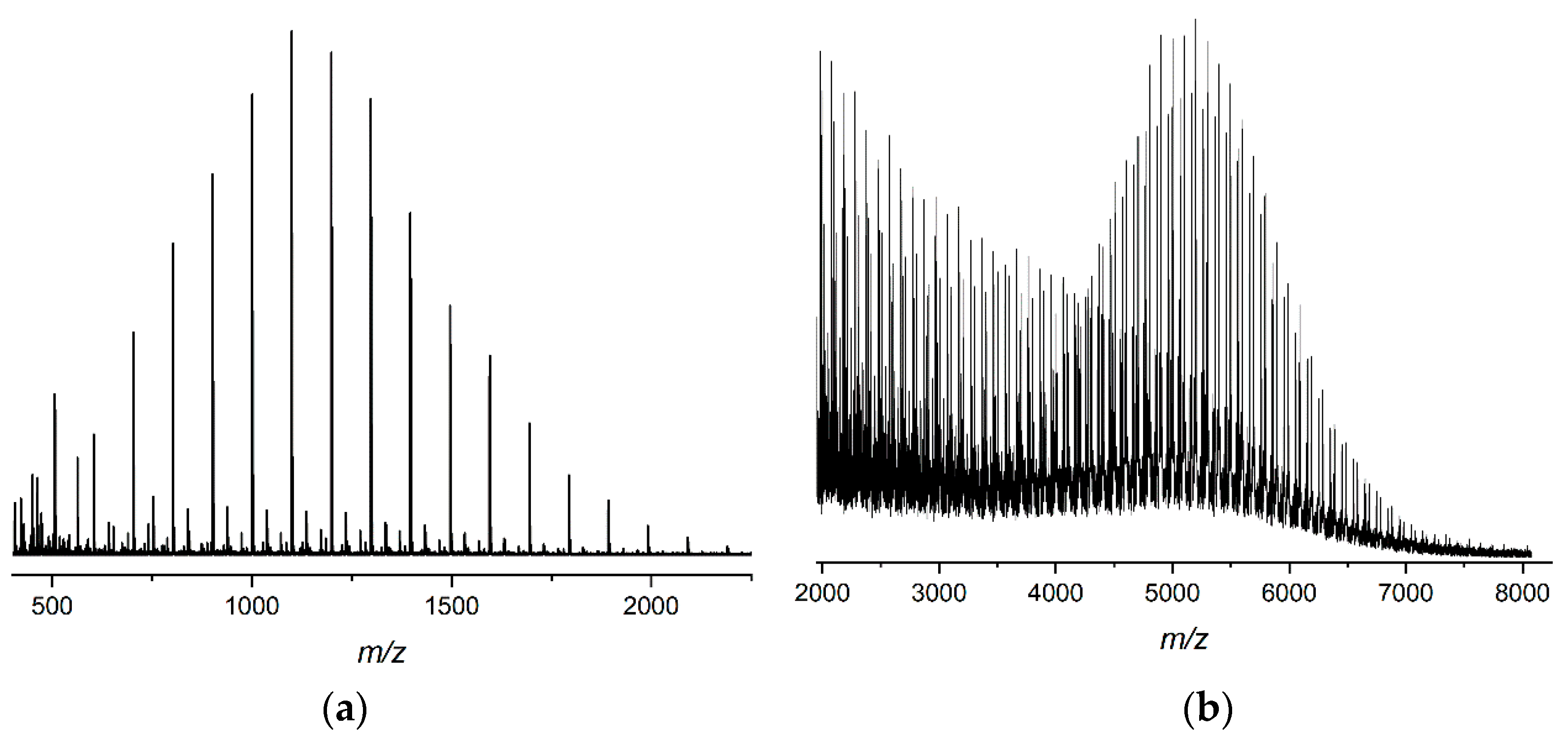
| Water Amount: Mann Whitney u-Test | ||||||||||
| p-Values | A1 | A2 | A3 | A4 | B1 | B2 | B3 | B4 | PEG-DA | |
| A1 | n = 5 | 1.00 | 0.01 | 0.01 | 0.01 | 0.01 | 0.01 | 0.01 | 0.01 | 0.06 |
| A2 | n = 5 | 1.00 | 0.01 | 0.01 | 0.01 | 0.01 | 0.01 | 0.01 | 0.42 | |
| A3 | n = 5 | 1.00 | 0.01 | 0.01 | 0.01 | 0.01 | 0.01 | 0.01 | ||
| A4 | n = 5 | 1.00 | 0.01 | 0.01 | 0.01 | 0.01 | 0.01 | |||
| B1 | n = 5 | 1.00 | 0.01 | 0.01 | 0.01 | 0.01 | ||||
| B2 | n = 5 | 1.00 | 0.01 | 0.01 | 0.01 | |||||
| B3 | n = 5 | 1.00 | 0.01 | 0.01 | ||||||
| B4 | n = 5 | 1.00 | 0.01 | |||||||
| PEG-DA | n = 5 | 1.00 | ||||||||
| Sample Height Change: Mann Whitney u-Test | ||||||||||
| p-values | A1 | A2 | A3 | A4 | B1 | B2 | B3 | B4 | PEG-DA | |
| A1 | n = 5 | 1.00 | 0.31 | 0.01 | 0.01 | 0.22 | 0.10 | 0.01 | 0.01 | 0.22 |
| A2 | n = 5 | 1.00 | 0.01 | 0.01 | 0.15 | 0.03 | 0.01 | 0.01 | 0.06 | |
| A3 | n = 5 | 1.00 | 0.01 | 0.10 | 0.01 | 0.01 | 0.31 | 0.15 | ||
| A4 | n = 5 | 1.00 | 0.01 | 0.01 | 0.01 | 0.01 | 0.01 | |||
| B1 | n = 5 | 1.00 | 0.55 | 0.01 | 0.10 | 0.69 | ||||
| B2 | n = 5 | 1.00 | 0.01 | 0.02 | 1.00 | |||||
| B3 | n = 5 | 1.00 | 0.01 | 0.02 | ||||||
| B4 | n = 5 | 1.00 | 0.15 | |||||||
| PEG-DA | n = 5 | 1.00 | ||||||||
| Sample Diameter Change: Mann Whitney u-Test | ||||||||||
| p-values | A1 | A2 | A3 | A4 | B1 | B2 | B3 | B4 | PEG-DA | |
| A1 | n = 5 | 1.00 | 0.42 | 0.01 | 0.01 | 0.02 | 0.01 | 0.01 | 0.01 | 1.00 |
| A2 | n = 5 | 1.00 | 0.01 | 0.01 | 0.02 | 0.01 | 0.01 | 0.01 | 0.15 | |
| A3 | n = 5 | 1.00 | 0.01 | 0.01 | 0.01 | 0.15 | 0.06 | 0.01 | ||
| A4 | n = 5 | 1.00 | 0.01 | 0.01 | 0.01 | 0.01 | 0.01 | |||
| B1 | n = 5 | 1.00 | 0.01 | 0.01 | 0.01 | 0.01 | ||||
| B2 | n = 5 | 1.00 | 0.01 | 0.06 | 0.01 | |||||
| B3 | n = 5 | 1.00 | 0.01 | 0.01 | ||||||
| B4 | n = 5 | 1.00 | 0.01 | |||||||
| PEG-DA | n = 5 | 1.00 | ||||||||
| Principal Component | Eigenvalue | Variance | Cumulative Variance |
|---|---|---|---|
| 1 | 4.49 × 100 | 6.42 × 101 | 64.25 |
| 2 | 1.31 × 100 | 1.88 × 101 | 83.11 |
| 3 | 7.06 × 10−1 | 1.00 × 101 | 93.20 |
| 4 | 4.39 × 10−1 | 6.27 × 100 | 99.48 |
| 5 | 3.46 × 10−2 | 4.95 × 10−1 | 99.98 |
| 6 | 1.71 × 10−3 | 2.45 × 10−2 | 100.00 |
| 7 | 6.74 × 10−31 | 9.62 × 10−30 | 100.00 |
| 1st PC: Mann Whitney u-Test | ||||||||||
| p-values | A1 | A2 | A3 | A4 | B1 | B2 | B3 | B4 | PEG-DA | |
| A1 | n = 20 | 1.000 | 0.168 | 0.001 | 0.001 | 0.128 | 0.014 | 0.001 | 0.001 | 0.001 |
| A2 | n = 24 | 1.000 | 0.001 | 0.002 | 0.829 | 0.317 | 0.001 | 0.001 | 0.001 | |
| A3 | n = 24 | 1.000 | 0.016 | 0.001 | 0.001 | 0.001 | 0.001 | 0.001 | ||
| A4 | n = 24 | 1.000 | 0.001 | 0.040 | 0.048 | 0.452 | 0.010 | |||
| B1 | n = 24 | 1.000 | 0.146 | 0.001 | 0.001 | 0.001 | ||||
| B2 | n = 24 | 1.000 | 0.001 | 0.001 | 0.001 | |||||
| B3 | n = 28 | 1.000 | 0.065 | 0.537 | ||||||
| B4 | n = 24 | 1.000 | 0.044 | |||||||
| PEG-DA | n = 20 | 1.000 | ||||||||
| Maxima of Storage Modulus: Mann Whitney u-Test | ||||||||||
| p-values | A1 | A2 | A3 | A4 | B1 | B2 | B3 | B4 | PEG-DA | |
| A1 | n = 20 | 1.000 | 0.058 | 0.001 | 0.001 | 0.092 | 0.003 | 0.001 | 0.001 | 0.001 |
| A2 | n = 24 | 1.000 | 0.001 | 0.001 | 0.813 | 0.106 | 0.001 | 0.001 | 0.001 | |
| A3 | n = 24 | 1.000 | 0.049 | 0.001 | 0.001 | 0.019 | 0.001 | 0.001 | ||
| A4 | n = 24 | 1.000 | 0.001 | 0.028 | 0.025 | 0.158 | 0.009 | |||
| B1 | n = 24 | 1.000 | 0.074 | 0.001 | 0.001 | 0.001 | ||||
| B2 | n = 24 | 1.000 | 0.001 | 0.001 | 0.001 | |||||
| B3 | n = 28 | 1.000 | 0.051 | 0.198 | ||||||
| B4 | n = 24 | 1.000 | 0.101 | |||||||
| PEG-DA | n = 20 | 1.000 | ||||||||
| Minima of Storage Modulus: Mann Whitney u-Test | ||||||||||
| p-values | A1 | A2 | A3 | A4 | B1 | B2 | B3 | B4 | PEG-DA | |
| A1 | n = 20 | 1.000 | 0.207 | 0.001 | 0.001 | 0.026 | 0.001 | 0.001 | 0.001 | 0.001 |
| A2 | n = 24 | 1.000 | 0.001 | 0.001 | 0.059 | 0.001 | 0.001 | 0.001 | 0.001 | |
| A3 | n = 24 | 1.000 | 0.049 | 0.001 | 0.001 | 0.001 | 0.001 | 0.001 | ||
| A4 | n = 24 | 1.000 | 0.001 | 0.078 | 0.013 | 0.020 | 0.008 | |||
| B1 | n = 24 | 1.000 | 0.001 | 0.001 | 0.001 | 0.001 | ||||
| B2 | n = 24 | 1.000 | 0.001 | 0.001 | 0.001 | |||||
| B3 | n = 28 | 1.000 | 0.653 | 0.058 | ||||||
| B4 | n = 24 | 1.000 | 0.316 | |||||||
| PEG-DA | n = 20 | 1.000 | ||||||||
| Storage Modulus at Maxima of Loss Modulus: Mann Whitney u-Test | ||||||||||
| p-values | A1 | A2 | A3 | A4 | B1 | B2 | B3 | B4 | PEG-DA | |
| A1 | n = 20 | 1.000 | 0.039 | 0.001 | 0.001 | 0.035 | 0.001 | 0.001 | 0.001 | 0.001 |
| A2 | n = 24 | 1.000 | 0.001 | 0.001 | 0.688 | 0.025 | 0.001 | 0.001 | 0.001 | |
| A3 | n = 24 | 1.000 | 0.049 | 0.001 | 0.001 | 0.202 | 0.014 | 0.003 | ||
| A4 | n = 24 | 1.000 | 0.001 | 0.031 | 0.012 | 0.049 | 0.009 | |||
| B1 | n = 24 | 1.000 | 0.021 | 0.001 | 0.001 | 0.001 | ||||
| B2 | n = 24 | 1.000 | 0.001 | 0.001 | 0.001 | |||||
| B3 | n = 28 | 1.000 | 0.074 | 0.164 | ||||||
| B4 | n = 24 | 1.000 | 0.225 | |||||||
| PEG-DA | n = 20 | 1.000 | ||||||||
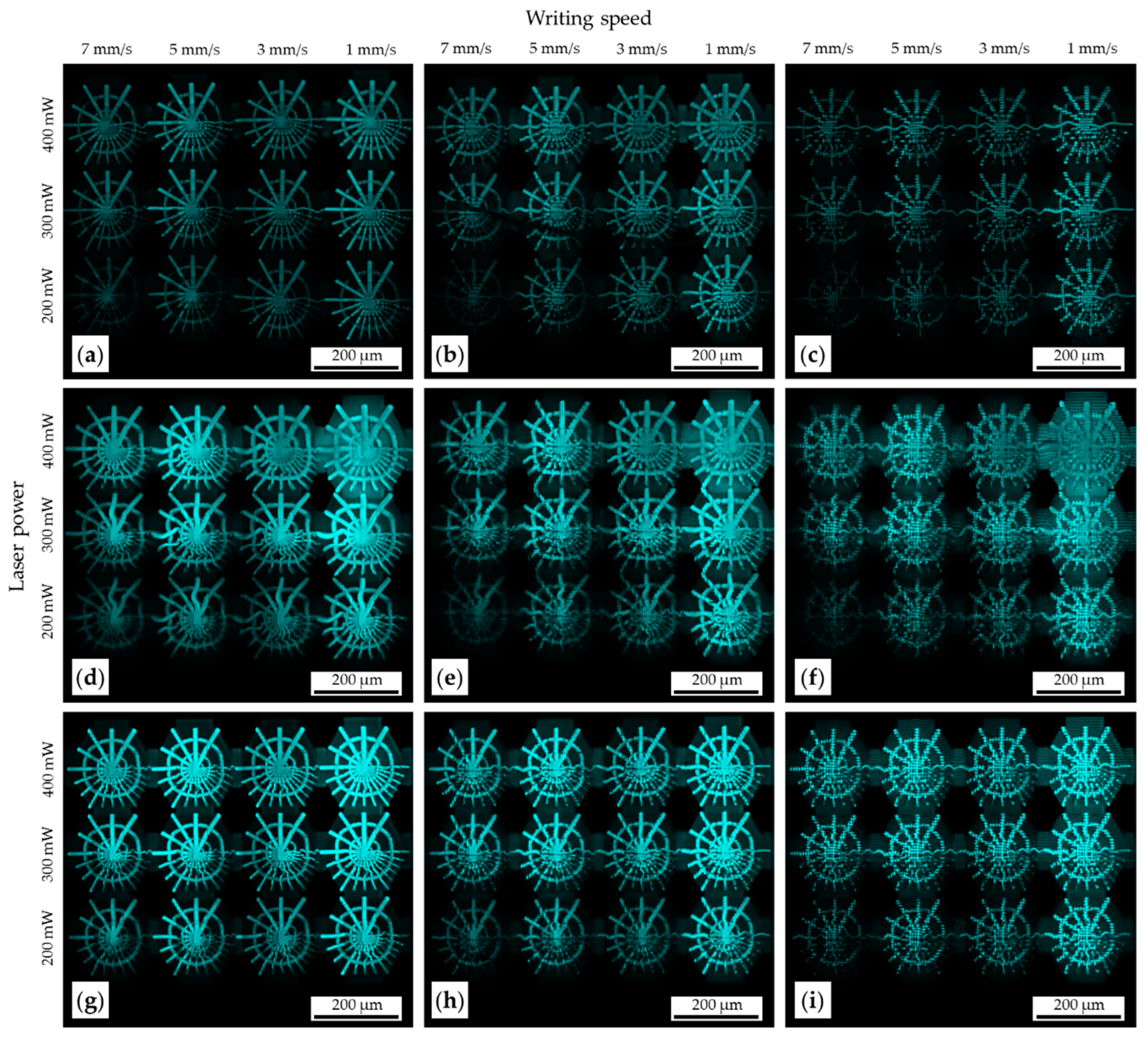
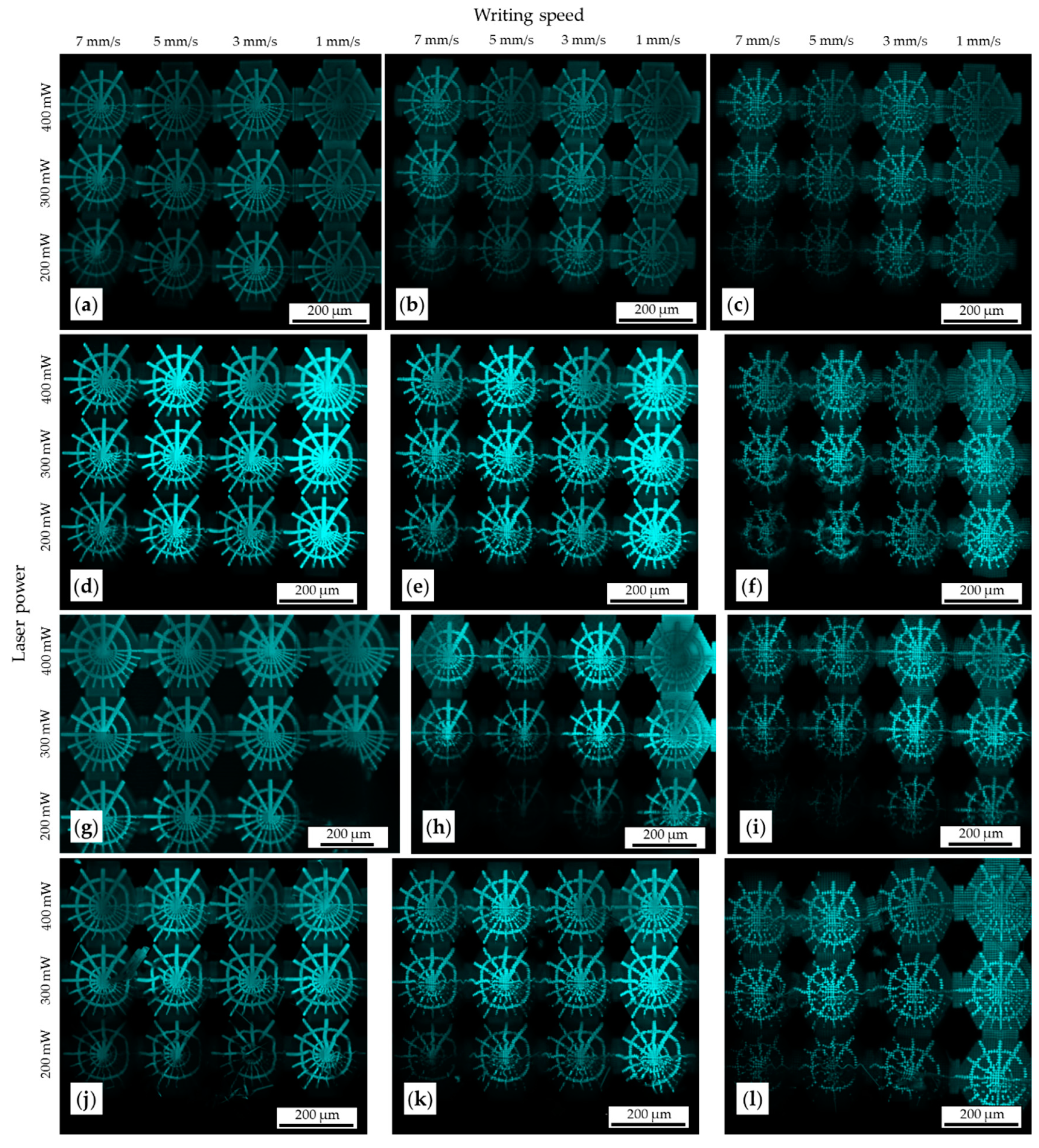

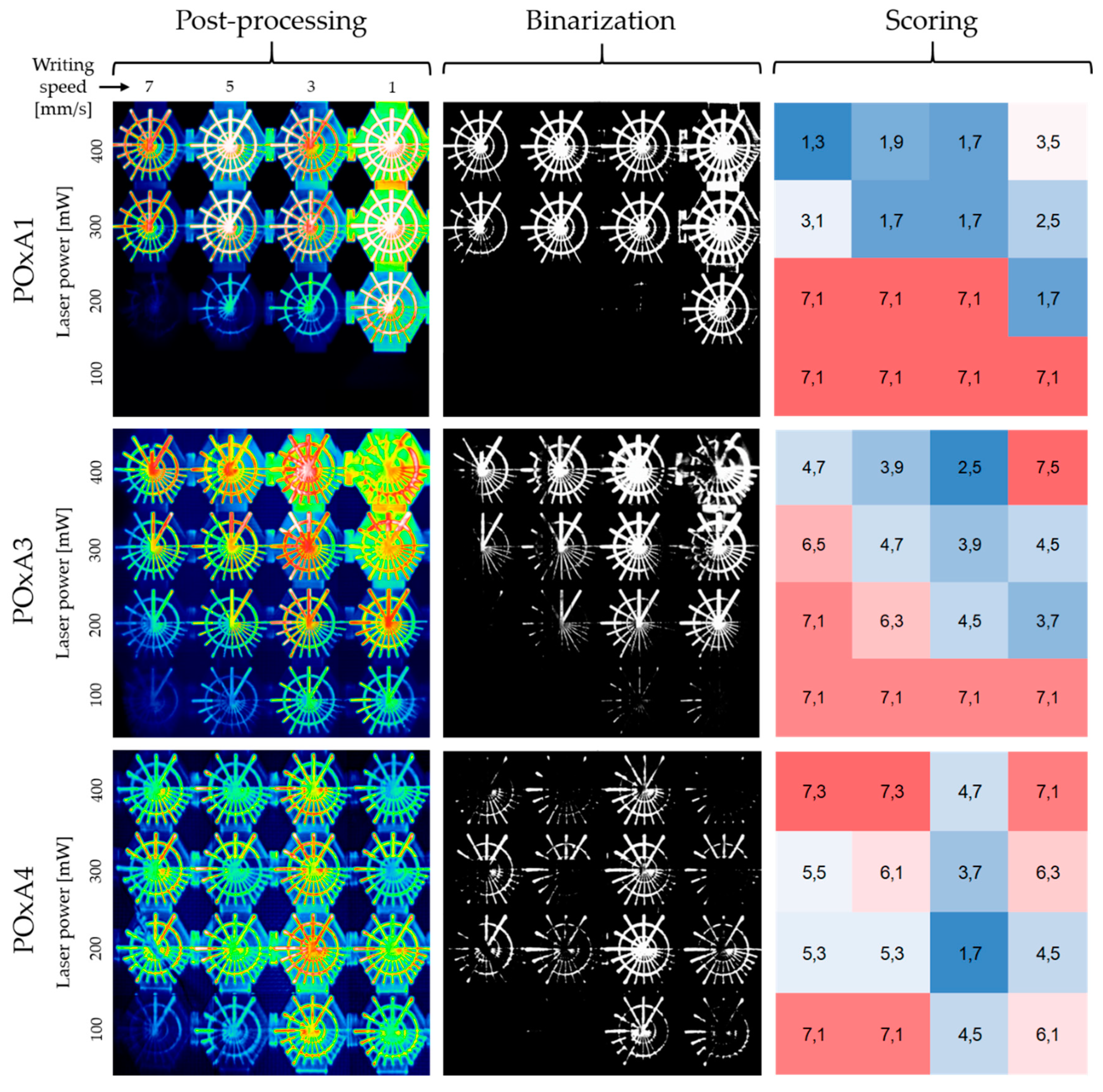
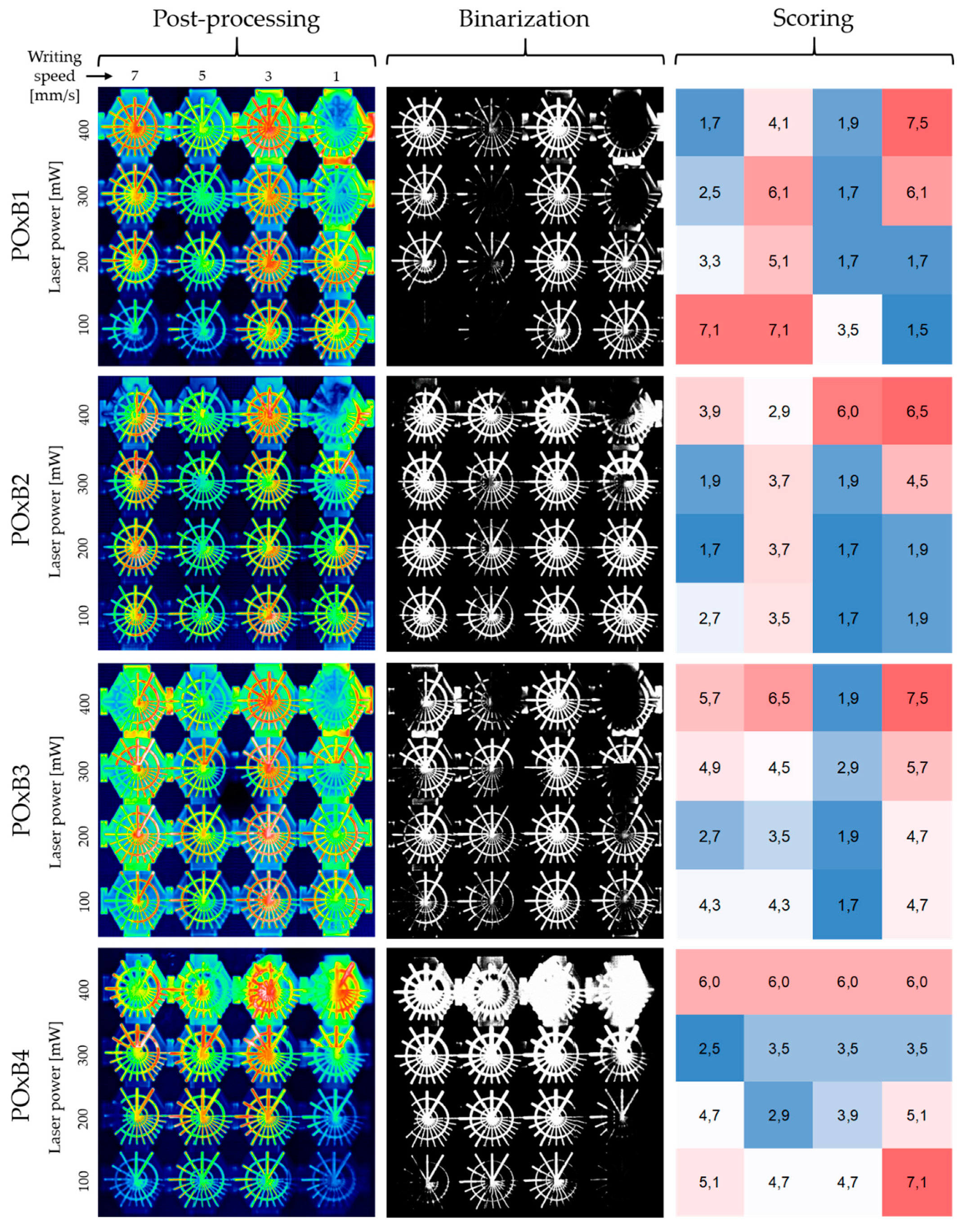
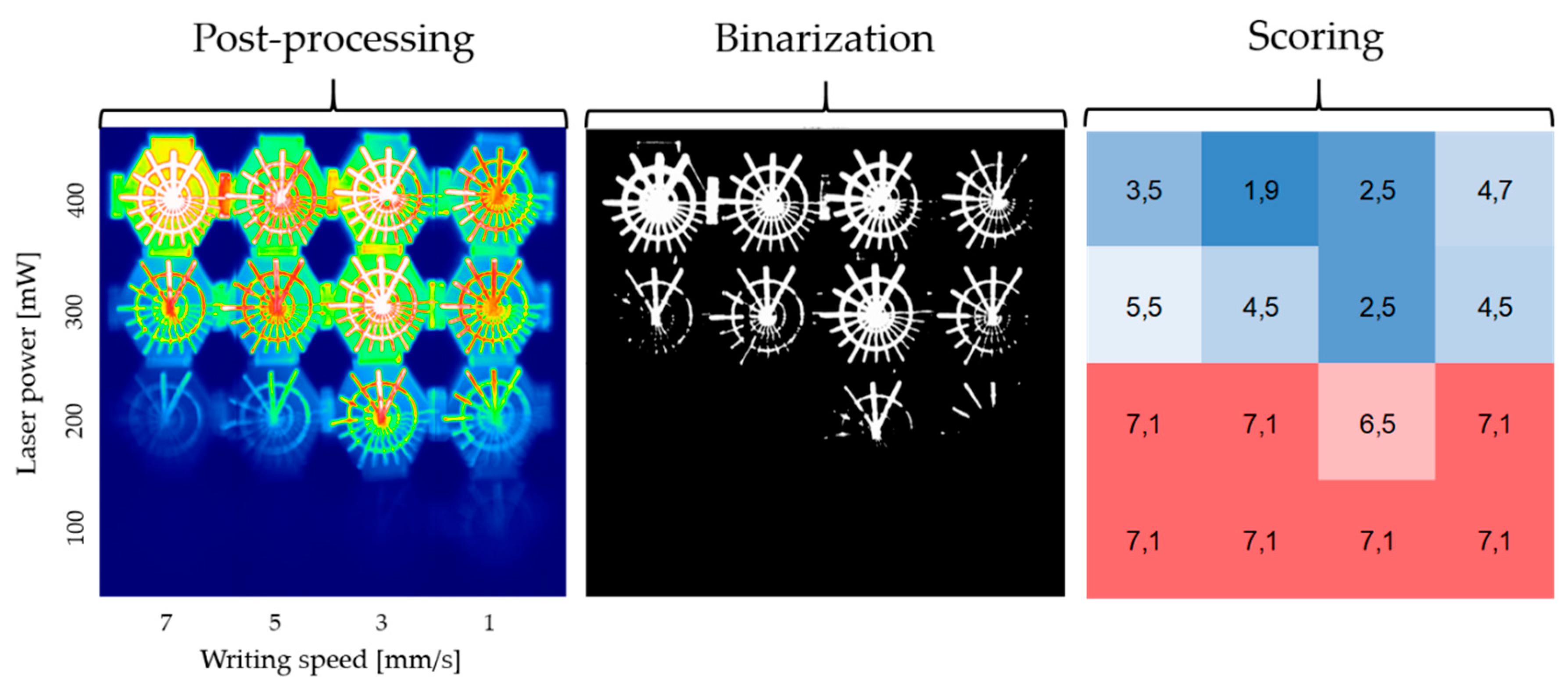
References
- Vert, M.; Doi, Y.; Hellwich, K.-H.; Hess, M.; Hodge, P.; Kubisa, P.; Rinaudo, M.; Schué, F. Terminology for biorelated polymers and applications (iupac recommendations 2012). Pure Appl. Chem. 2012, 84, 377–410. [Google Scholar] [CrossRef]
- Tathe, A.; Ghodke, M.; Nikalje, A.P. A brief review: Biomaterials and their application. Int. J. Pharm. Pharm. Sci. 2010, 2, 19–23. [Google Scholar]
- Nikolova, M.P.; Chavali, M.S. Recent advances in biomaterials for 3D scaffolds: A review. Bioact. Mater. 2019, 4, 271–292. [Google Scholar] [CrossRef]
- Song, R.; Murphy, M.; Li, C.; Ting, K.; Soo, C.; Zheng, Z. Current development of biodegradable polymeric materials for biomedical applications. Drug Des. Dev. Ther. 2018, 12, 3117–3145. [Google Scholar] [CrossRef]
- Taubenberger, A.V.; Bray, L.J.; Haller, B.; Shaposhnykov, A.; Binner, M.; Freudenberg, U.; Guck, J.; Werner, C. 3D extracellular matrix interactions modulate tumour cell growth, invasion and angiogenesis in engineered tumour microenvironments. Acta Biomater. 2016, 36, 73–85. [Google Scholar] [CrossRef] [PubMed]
- Vazin, T.; Schaffer, D.V. Engineering strategies to emulate the stem cell niche. Trends Biotechnol. 2010, 28, 117–124. [Google Scholar] [CrossRef] [PubMed]
- West, J.L.; Moon, J.J. Vascularization of engineered tissues: Approaches to promote angiogenesis in biomaterials. Curr. Top. Med. Chem. 2008, 8, 300–310. [Google Scholar] [CrossRef] [PubMed]
- Hauptmann, N.; Lian, Q.; Ludolph, J.; Rothe, H.; Hildebrand, G.; Liefeith, K. Biomimetic designer scaffolds made of d, l-lactide-ɛ-caprolactone polymers by 2-photon polymerization. Tissue Eng. Part B Rev. 2019, 25, 167–186. [Google Scholar] [CrossRef] [PubMed]
- Thavornyutikarn, B.; Chantarapanich, N.; Sitthiseripratip, K.; Thouas, G.A.; Chen, Q. Bone tissue engineering scaffolding: Computer-aided scaffolding techniques. Prog. Biomater. 2014, 3, 61–102. [Google Scholar] [CrossRef] [PubMed]
- Moroni, L.; Nandakumar, A.; de Groot, F.B.; van Blitterswijk, C.A.; Habibovic, P. Plug and play: Combining materials and technologies to improve bone regenerative strategies. J. Tissue Eng. Regen. Med. 2015, 9, 745–759. [Google Scholar] [CrossRef]
- Nam, S.; Lee, J.; Brownfield, D.G.; Chaudhuri, O. Viscoplasticity enables mechanical remodeling of matrix by cells. Biophys. J. 2016, 111, 2296–2308. [Google Scholar] [CrossRef]
- Engler, A.J.; Sen, S.; Sweeney, H.L.; Discher, D.E. Matrix elasticity directs stem cell lineage specification. Cell 2006, 126, 677–689. [Google Scholar] [CrossRef]
- Dokukina, I.V.; Gracheva, M.E. A model of fibroblast motility on substrates with different rigidities. Biophys. J. 2010, 98, 2794–2803. [Google Scholar] [CrossRef]
- Discher, D.E.; Janmey, P.; Wang, Y.-L. Tissue cells feel and respond to the stiffness of their substrate. Science 2005, 310, 1139–1143. [Google Scholar] [CrossRef]
- Emon, B.; Bauer, J.; Jain, Y.; Jung, B.; Saif, T. Biophysics of tumor microenvironment and cancer metastasis—A mini review. Comput. Struct. Biotechnol. J. 2018, 16, 279–287. [Google Scholar] [CrossRef] [PubMed]
- Neel, J.-C.; Humbert, L.; Lebrun, J.-J. The dual role of TGFβ in human cancer: From tumor suppression to cancer metastasis. ISRN Mol. Biol. 2012, 2012. [Google Scholar] [CrossRef]
- Pouliot, N.; Pearson, H.B.; Burrows, A. Investigating metastasis using in vitro platforms. In Madame Curie Bioscience Database [Internet]; Landes Bioscience: Austin, TX, USA, 2013. [Google Scholar]
- Lo, C.-M.; Wang, H.-B.; Dembo, M.; Wang, Y.-L. Cell movement is guided by the rigidity of the substrate. Biophys. J. 2000, 79, 144–152. [Google Scholar] [CrossRef]
- Petrie, R.J.; Doyle, A.D.; Yamada, K.M. Random versus directionally persistent cell migration. Nat. Rev. Mol. Cell Biol. 2009, 10, 538–549. [Google Scholar] [CrossRef] [PubMed]
- Zamani, Y.; Amoabediny, G.; Mohammadi, J.; Seddiqi, H.; Helder, M.N.; Zandieh-Doulabi, B.; Klein-Nulend, J.; Koolstra, J.H. 3D-printed poly(ε-caprolactone) scaffold with gradient mechanical properties according to force distribution in the mandible for mandibular bone tissue engineering. J. Mech. Behav. Biomed. Mater. 2020, 104, 103638. [Google Scholar] [CrossRef]
- Mullender, M.; El Haj, A.; Yang, Y.; Van Duin, M.; Burger, E.; Klein-Nulend, J. Mechanotransduction of bone cells in vitro: Mechanobiology of bone tissue. Med. Biol. Eng. Comput. 2004, 42, 14–21. [Google Scholar] [CrossRef] [PubMed]
- Hoffman, A.S. Hydrogels for biomedical applications. Adv. Drug Deliv. Rev. 2012, 64, 18–23. [Google Scholar] [CrossRef]
- Bludau, H.; Czapar, A.E.; Pitek, A.S.; Shukla, S.; Jordan, R.; Steinmetz, N.F. Poxylation as an alternative stealth coating for biomedical applications. Eur. Polym. J. 2017, 88, 679–688. [Google Scholar] [CrossRef] [PubMed]
- Knop, K.; Hoogenboom, R.; Fischer, D.; Schubert, U.S. Poly-(ethylene glycol) in drug delivery: Pros and cons as well as potential alternatives. Angew. Chem. Int. Ed. 2010, 49, 6288–6308. [Google Scholar] [CrossRef] [PubMed]
- Woodle, M.C.; Engbers, C.M.; Zalipsky, S. New amphipatic polymer-lipid conjugates forming long-circulating reticuloendothelial system-evading liposomes. Bioconjug. Chem. 1994, 5, 493–496. [Google Scholar] [CrossRef] [PubMed]
- Zalipsky, S.; Hansen, C.B.; Oaks, J.M.; Allen, T.M. Evaluation of blood clearance rates and biodistribution of poly(2-oxazoline)-grafted liposomes. J. Pharm. Sci. 1996, 85, 133–137. [Google Scholar] [CrossRef] [PubMed]
- Kronek, J.; Kronekova, Z.; Luston, J.; Paulovicova, E.; Paulovicova, L.; Mendrek, B. In vitro bio-immunological and cytotoxicity studies of poly(2-oxazolines). J. Mater. Sci. Mater. Med. 2011, 22, 1725–1734. [Google Scholar] [CrossRef]
- Kronek, J.; Paulovicova, E.; Paulovicova, L.; Kronekova, Z.; Luston, J. Immunomodulatory efficiency of poly(2-oxazolines). J. Mater. Sci. Mater. Med. 2012, 23, 1457–1464. [Google Scholar] [CrossRef]
- Bauer, M.; Schroeder, S.; Tauhardt, L.; Kempe, K.; Schubert, U.S.; Fischer, D. In vitro hemocompatibility and cytotoxicity study of poly (2-methyl-2-oxazoline) for biomedical applications. J. Polym. Sci. Part A Polym. Chem. 2013, 51, 1816–1821. [Google Scholar] [CrossRef]
- Mees, M.A.; Hoogenboom, R. Functional poly (2-oxazoline) s by direct amidation of methyl ester side chains. Macromolecules 2015, 48, 3531–3538. [Google Scholar] [CrossRef]
- Luxenhofer, R.; Han, Y.; Schulz, A.; Tong, J.; He, Z.; Kabanov, A.V.; Jordan, R. Poly(2-oxazoline) s as polymer therapeutics. Macromol. Rapid Commun. 2012, 33, 1613–1631. [Google Scholar] [CrossRef]
- Zahoranová, A.; Kroneková, Z.; Zahoran, M.; Chorvát Jr, D.; Janigová, I.; Kronek, J. Poly(2-oxazoline) hydrogels crosslinked with aliphatic bis (2-oxazoline) s: Properties, cytotoxicity, and cell cultivation. J. Polym. Sci. Pol. Chem. 2016, 54, 1548–1559. [Google Scholar] [CrossRef]
- Farrugia, B.L.; Kempe, K.; Schubert, U.S.; Hoogenboom, R.; Dargaville, T.R. Poly(2-oxazoline) hydrogels for controlled fibroblast attachment. Biomacromolecules 2013, 14, 2724–2732. [Google Scholar] [CrossRef] [PubMed]
- Christova, D.; Velichkova, R.; Goethals, E.J.; Du Prez, F.E. Amphiphilic segmented polymer networks based on poly(2-alkyl-2-oxazoline) and poly(methyl methacrylate). Polymer 2002, 43, 4585–4590. [Google Scholar] [CrossRef]
- Christova, D.; Velichkova, R.; Loos, W.; Goethals, E.J.; Du Prez, F. New thermo-responsive polymer materials based on poly(2-ethyl-2-oxazoline) segments. Polymer 2003, 44, 2255–2261. [Google Scholar] [CrossRef]
- Christova, D.; Velichkova, R.; Goethals, E.J. Bis-macromonomers of 2-alkyl-2-oxazolines–synthesis and polymerization. Macromol. Rapid Comm. 1997, 18, 1067–1073. [Google Scholar] [CrossRef]
- Wloka, T.; Czich, S.; Kleinsteuber, M.; Moek, E.; Weber, C.; Gottschaldt, M.; Liefeith, K.; Schubert, U.S. Microfabrication of 3D-hydrogels via two-photon polymerization of poly (2-ethyl-2-oxazoline) diacrylates. Eur. Polym. J. 2020, 122, 109295. [Google Scholar] [CrossRef]
- Weber, C.; Becer, C.R.; Hoogenboom, R.; Schubert, U.S. Lower critical solution temperature behavior of comb and graft shaped poly [oligo (2-ethyl-2-oxazoline) methacrylate] s. Macromolecules 2009, 42, 2965–2971. [Google Scholar] [CrossRef]
- Weber, C.; Babiuch, K.; Rogers, S.; Perevyazko, I.Y.; Hoogenboom, R.; Schubert, U.S. Unexpected radical polymerization behavior of oligo(2-ethyl-2-oxazoline) macromonomers. Polym. Chem. 2012, 3, 2976–2985. [Google Scholar] [CrossRef]
- Kempe, K.; Neuwirth, T.; Czaplewska, J.; Gottschaldt, M.; Hoogenboom, R.; Schubert, U.S. Poly (2-oxazoline) glycopolymers with tunable lcst behavior. Polym. Chem. 2011, 2, 1737–1743. [Google Scholar] [CrossRef]
- Baumgaertel, A.; Weber, C.; Knop, K.; Crecelius, A.; Schubert, U.S. Characterization of different poly (2-ethyl-2-oxazoline) s via matrix-assisted laser desorption/ionization time-of-flight tandem mass spectrometry. Rapid Comm. Mass Spec. 2009, 23, 756–762. [Google Scholar] [CrossRef]
- Wiesbrock, F.; Hoogenboom, R.; Leenen, M.A.; Meier, M.A.; Schubert, U.S. Investigation of the living cationic ring-opening polymerization of 2-methyl-, 2-ethyl-, 2-nonyl-, and 2-phenyl-2-oxazoline in a single-mode microwave reactor. Macromolecules 2005, 38, 5025–5034. [Google Scholar] [CrossRef]
- Okay, O. General properties of hydrogels. In Hydrogel Sensors and Actuators; Springer: Berlin/Heidelberg, Germany, 2009; pp. 1–14. [Google Scholar]
- Ganji, F.; Vasheghani-Farahani, S.; Vasheghani-Farahani, E. Theoretical description of hydrogel swelling: A review. Iran. Polym. J. 2010, 19, 375–398. [Google Scholar]
- Poocza, L.; Gottschaldt, M.; Markweg, E.; Hauptmann, N.; Hildebrand, G.; Pretzel, D.; Hartlieb, M.; Reichardt, C.; Kübel, J.; Schubert, U.S. Optimized photoinitiator for fast two-photon absorption polymerization of polyester-macromers for tissue engineering. Adv. Eng. Mater. 2017, 19, 1600686. [Google Scholar] [CrossRef]
- Rechenberg, I. The evolution strategy. A mathematical model of darwinian evolution. In Synergetics—From Microscopic to Macroscopic order; Springer: Berlin/Heidelberg, Germany, 1984; pp. 122–132. [Google Scholar]
- Bäck, T. Evolutionary Algorithms in Theory and Practice: Evolution Strategies, Evolutionary Programming, Genetic Algorithms; Oxford University Press: Oxford, UK, 1996. [Google Scholar]
- Monaco, F.J.; Delbem, A.C.B.; Federson, F.M. Genetic algorithm for the determination of linear viscoelastic relaxation spectrum from experimental data. J. Appl. Polym. Sci. 2009, 113, 122–135. [Google Scholar] [CrossRef]
- Mera, N.S.; Elliott, L.; Ingham, D.B. On the use of genetic algorithms for solving ill-posed problems. Inverse Probl. Eng. 2003, 11, 105–121. [Google Scholar] [CrossRef]
- Mera, N.S.; Elliott, L.; Ingham, D.B. A multi-population genetic algorithm approach for solving ill-posed problems. Comput. Mech. 2004, 33, 254–262. [Google Scholar] [CrossRef]
- Michalewicz, Z. Evolution strategies and other methods. In Genetic Algorithms+ Data Structures= Evolution Programs; Springer: Berlin/Heidelberg, Germany, 1994; pp. 167–184. [Google Scholar]
- Schwefel, H. Evolution and Optimum Seeking; Wiley Interscience: New York, NY, USA, 1995. [Google Scholar]
- Abdi, H.; Williams, L.J. Principal component analysis. WIREs Comput. Stat. 2010, 2, 433–459. [Google Scholar] [CrossRef]
- The R Core Team. R: A Language and Environment for Statistical Computing, version 3.0.0; R Foundation for Statistical Computing: Vienna, Austria, 2012; edited in 2016 by computing r.F.F.S. [Google Scholar]
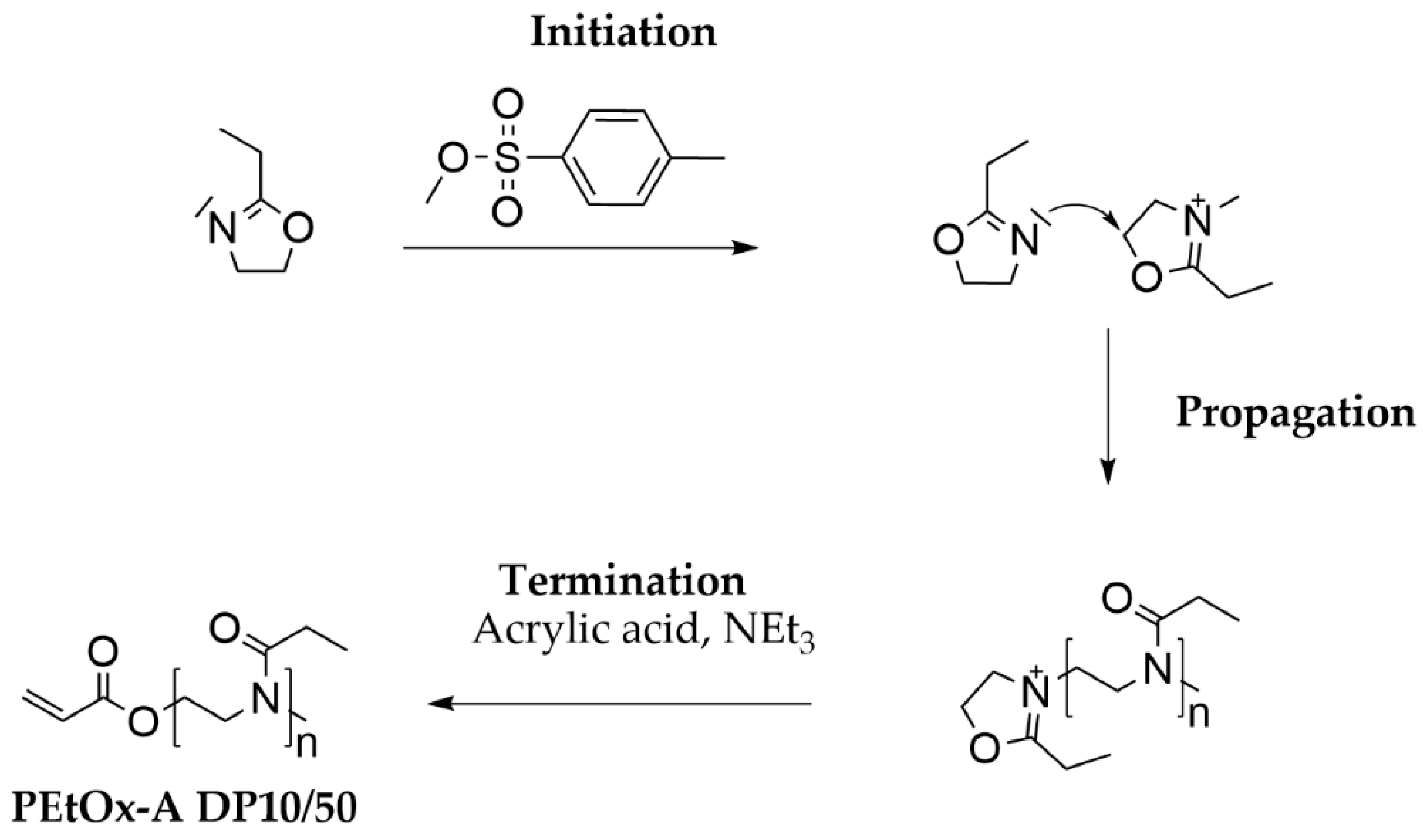
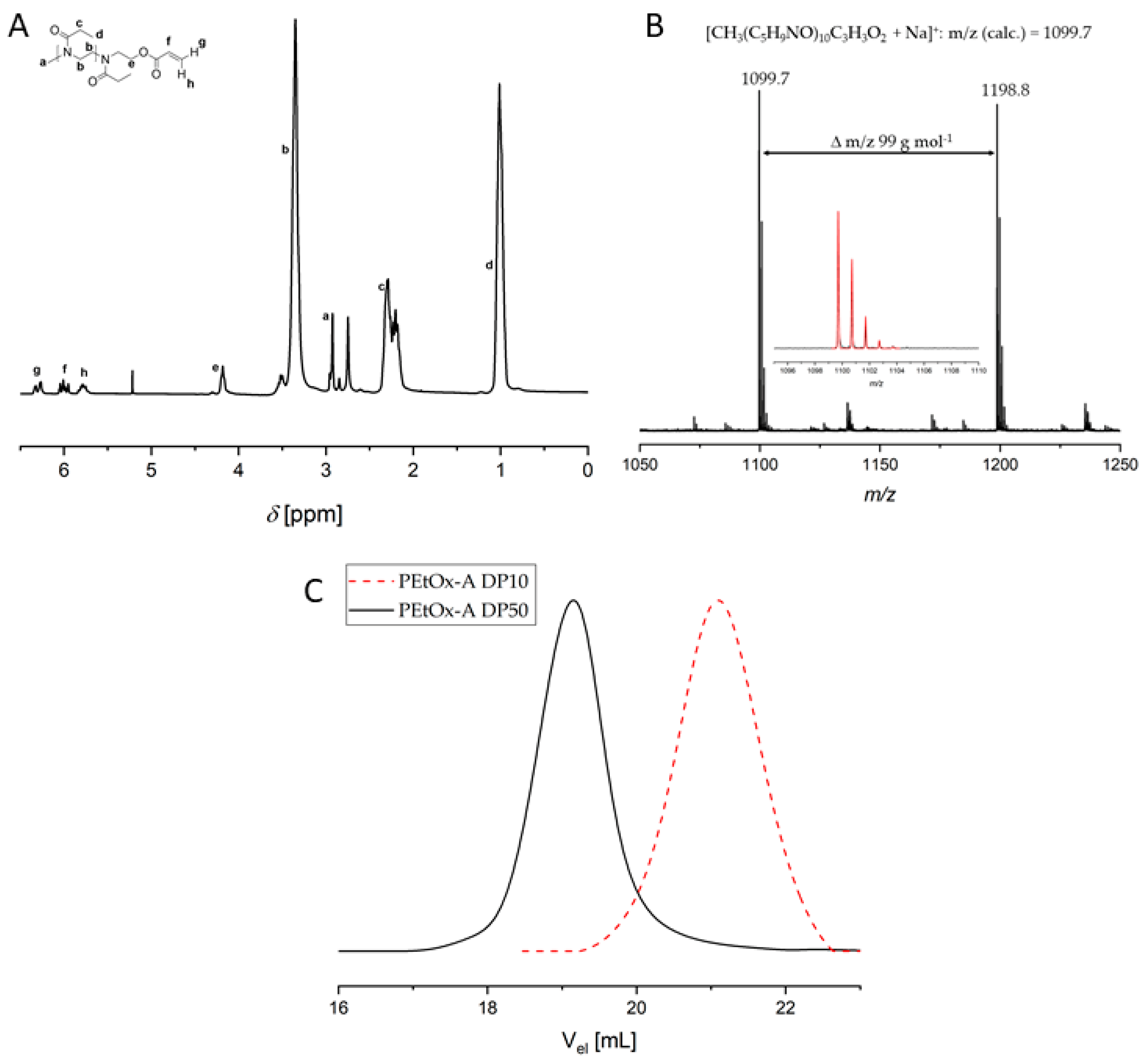
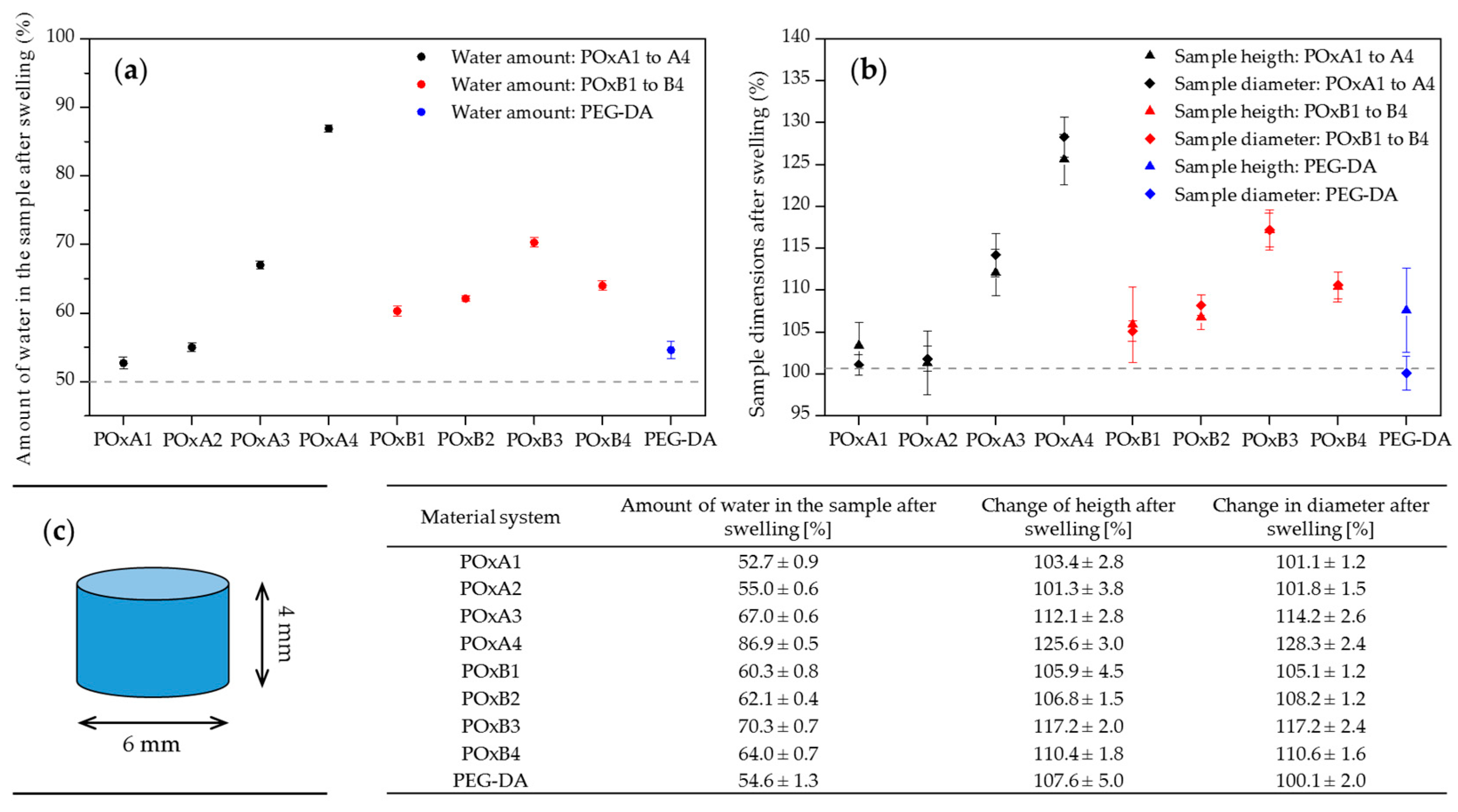
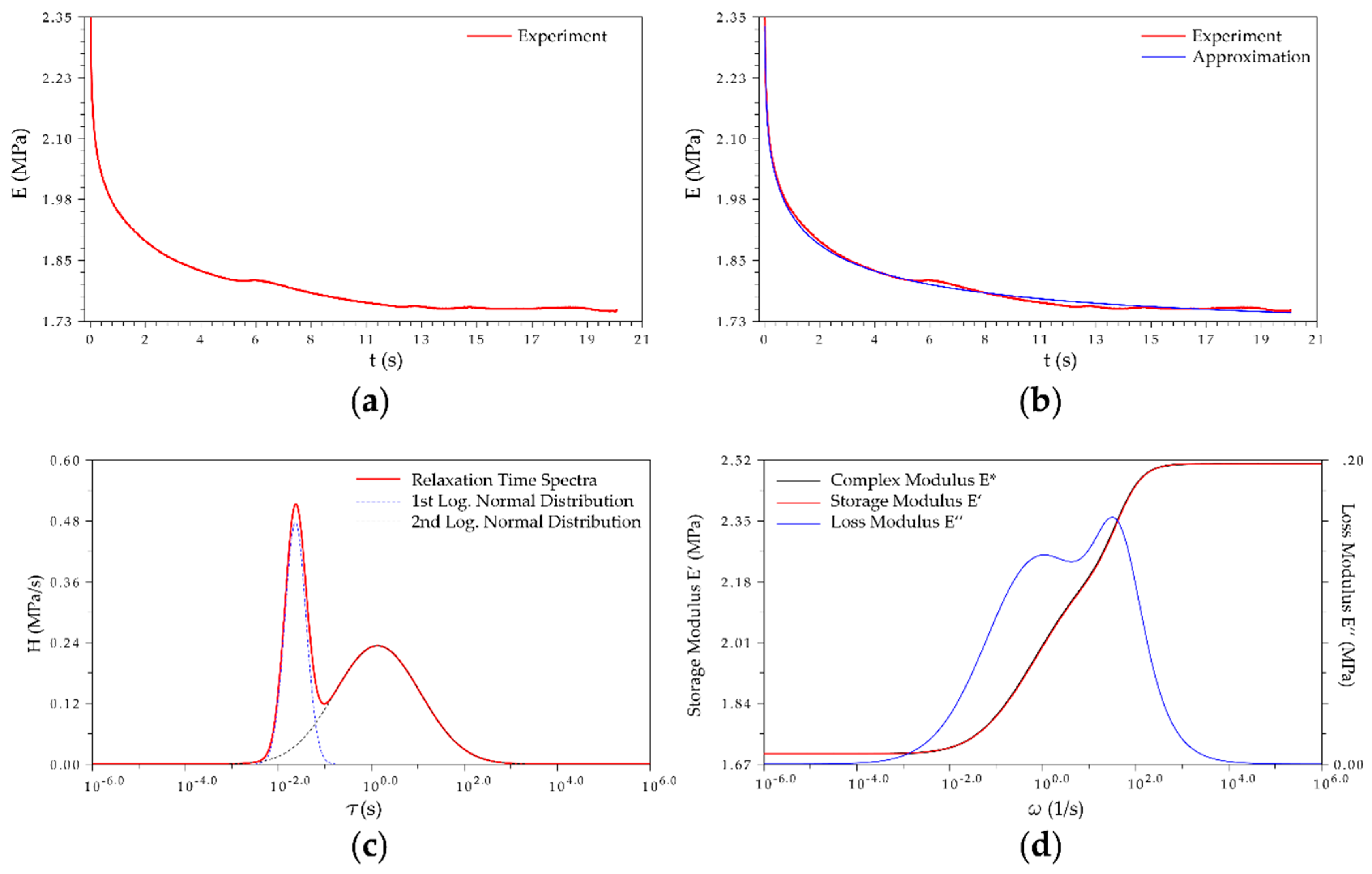
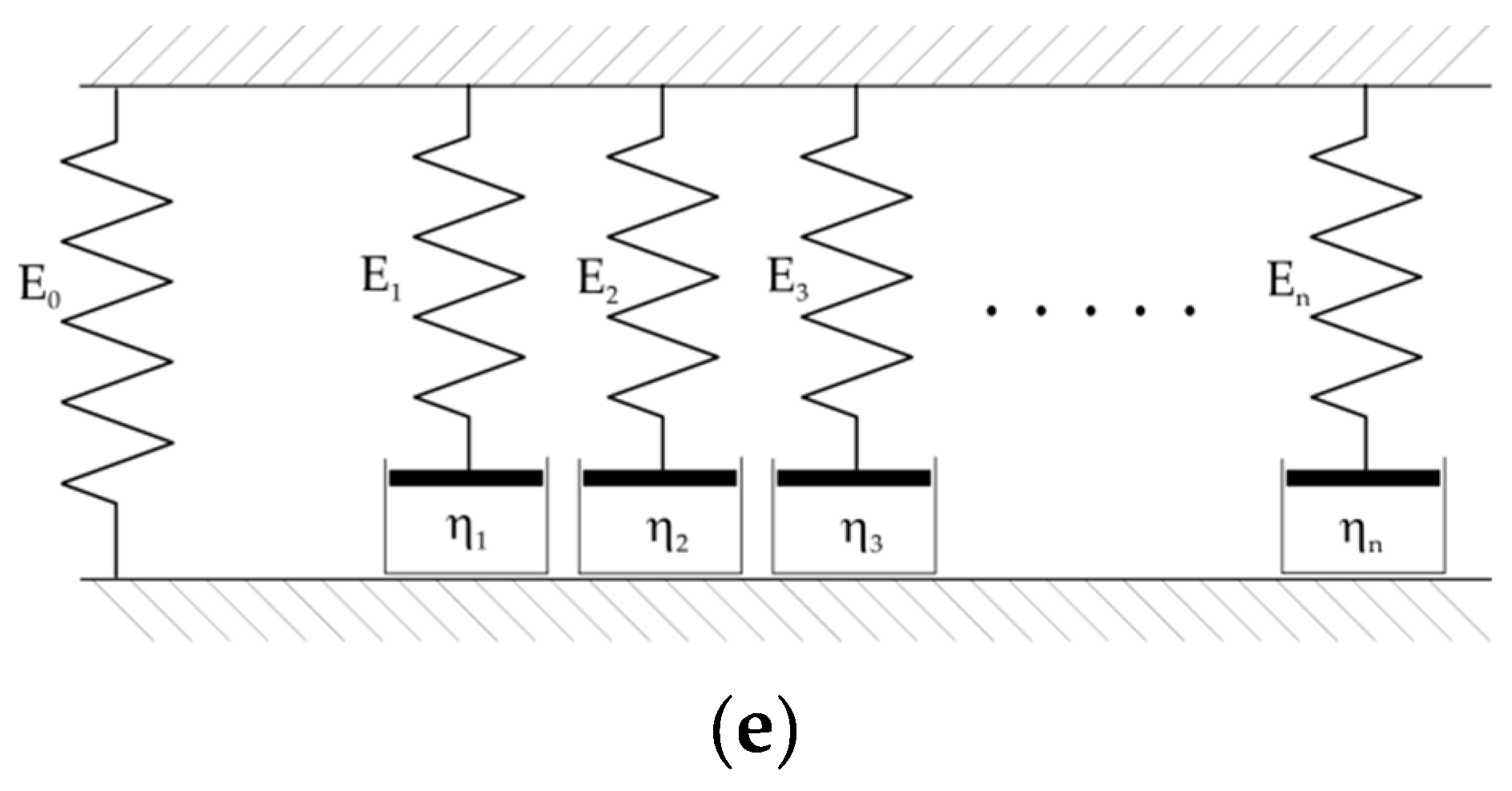
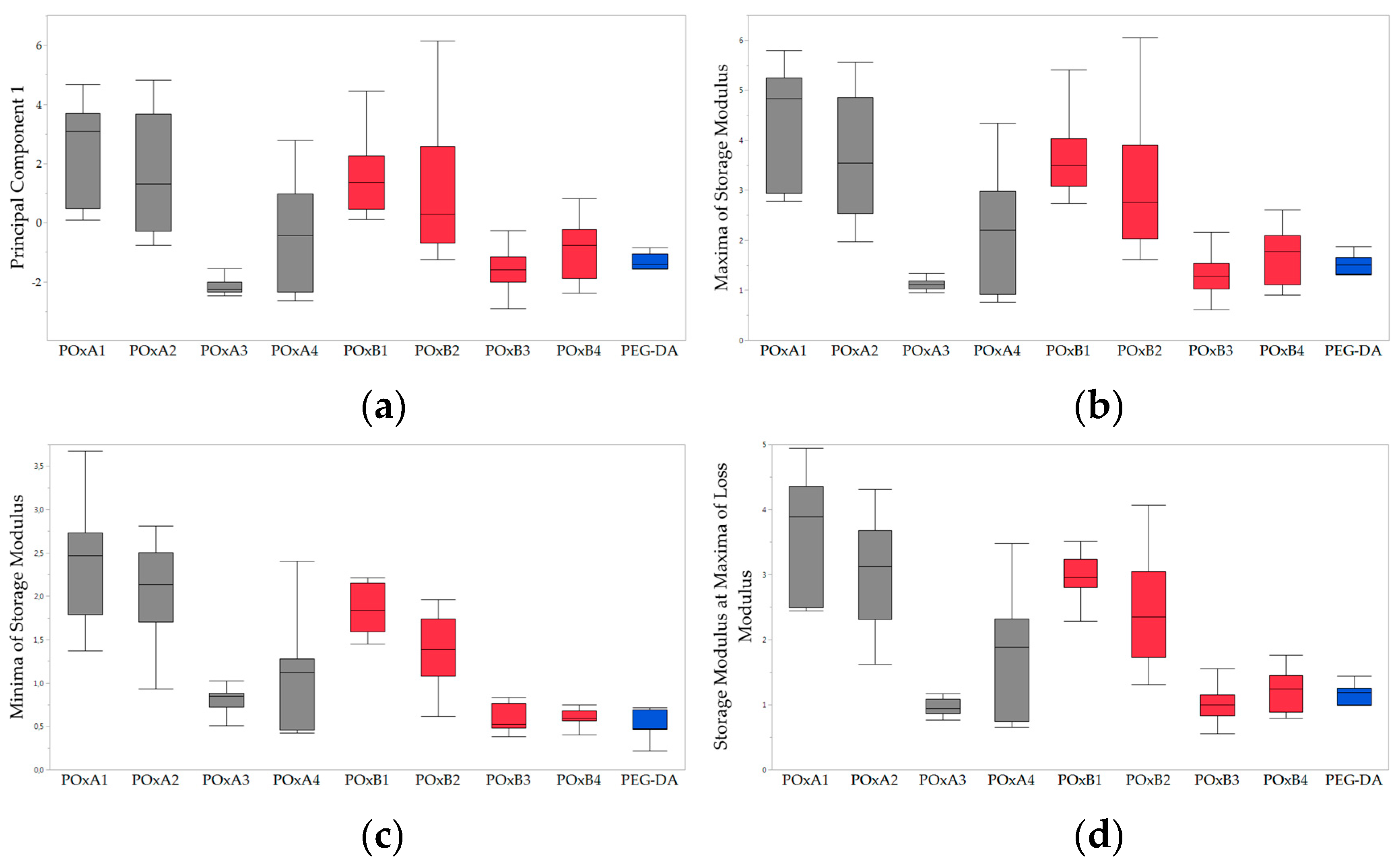
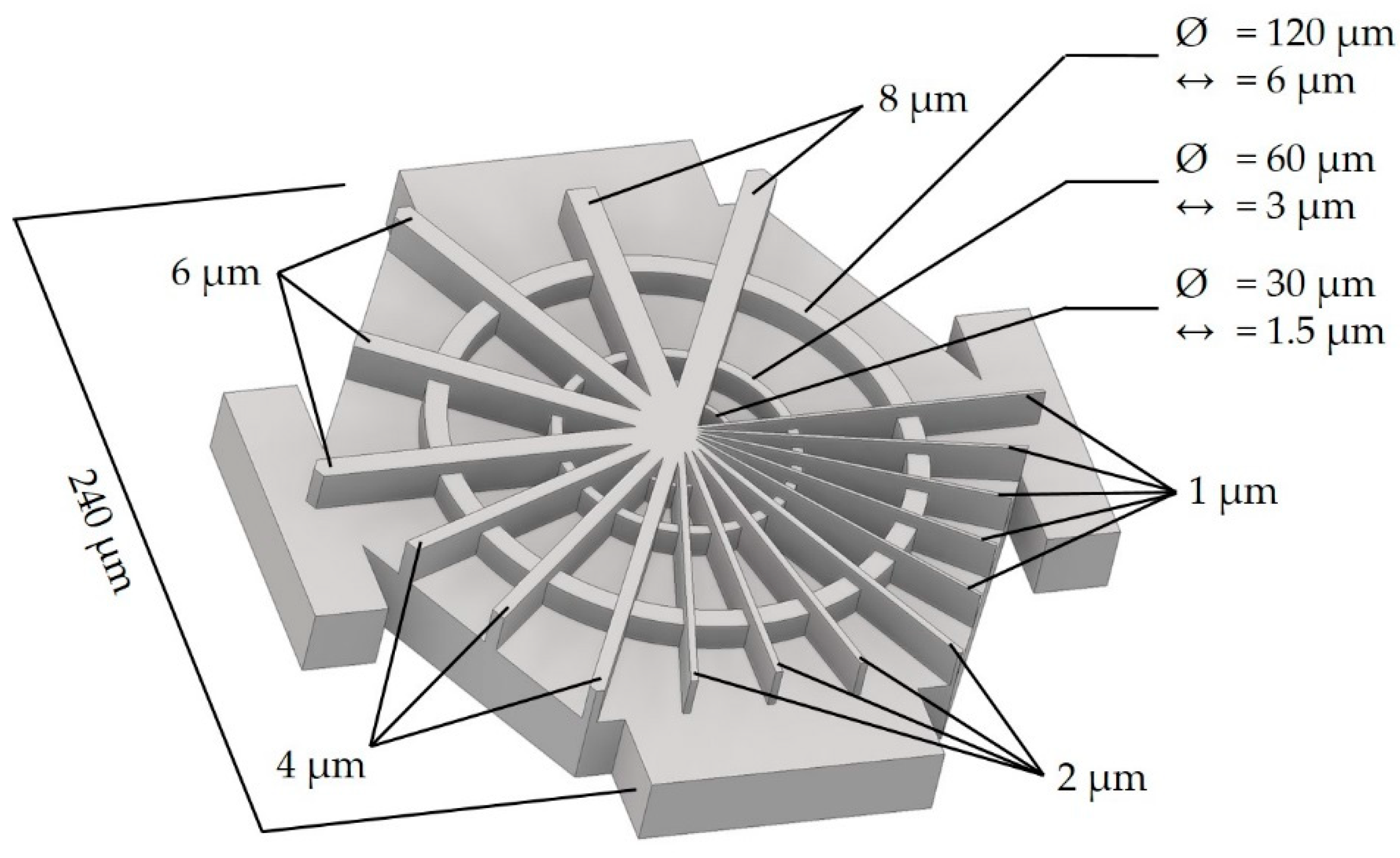
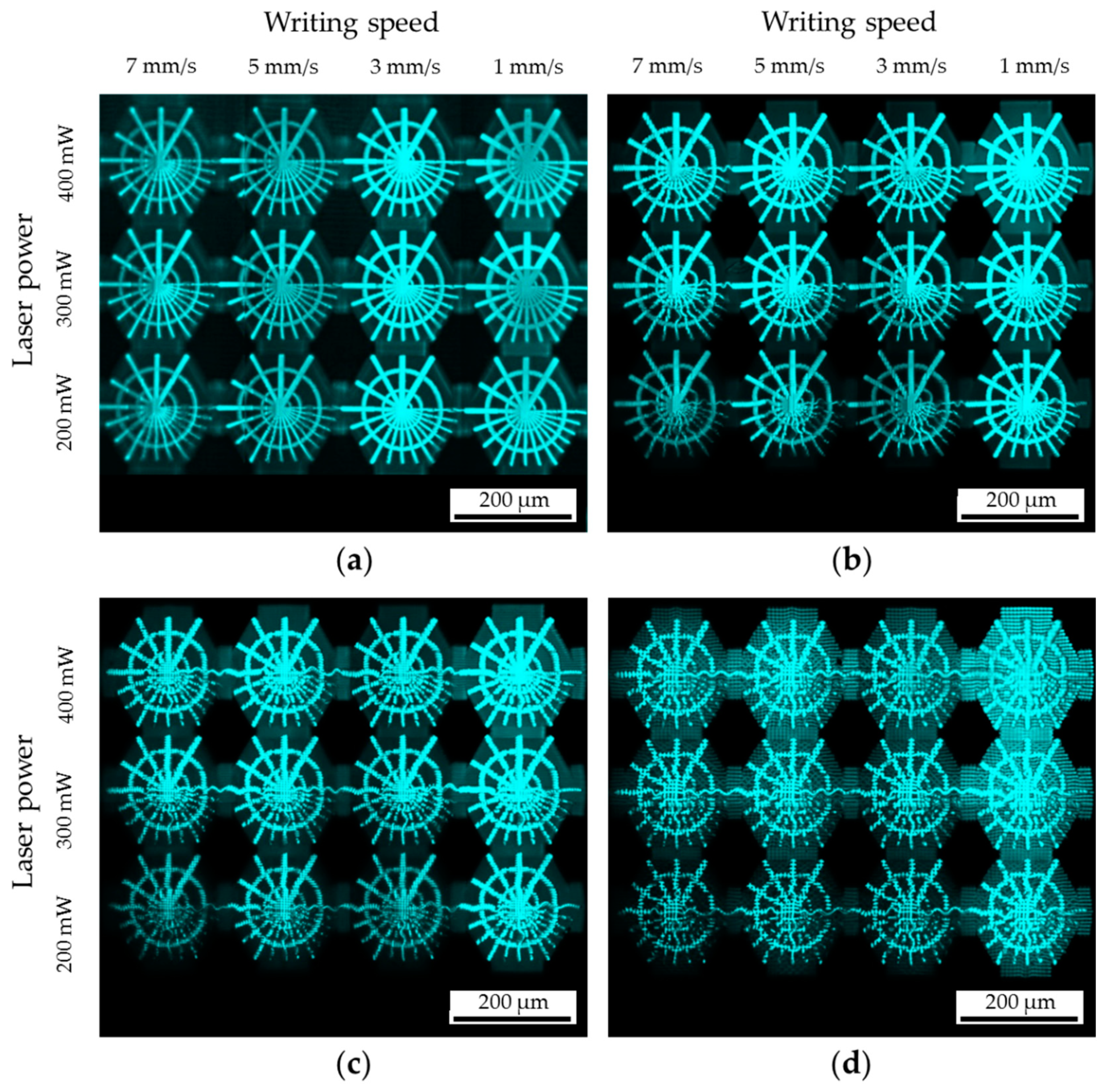
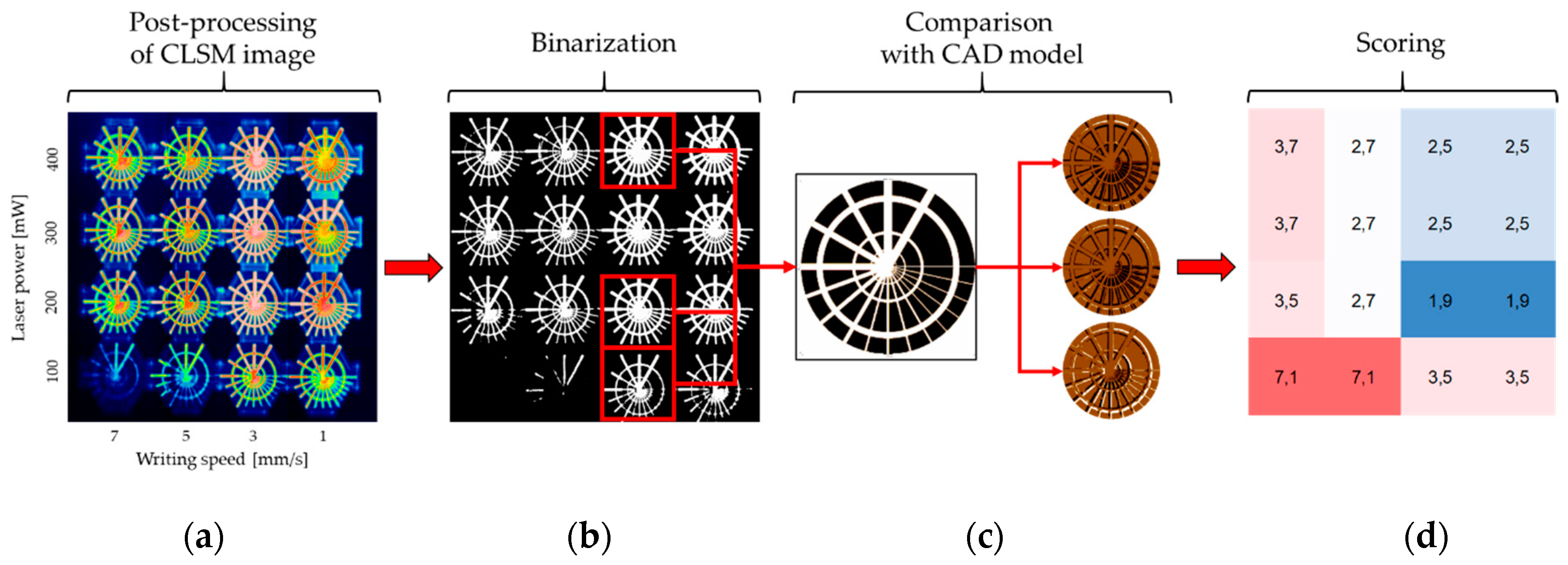
| [M]/[I] 1 | DPNMR 2 | DF 2 | Mn, NMR 2 (g mol−1) | Mn, SEC 3 (g mol−1) | Ð 3 | |
|---|---|---|---|---|---|---|
| PEtOx-A DP10 | 10 | 10 | 0.99 | 1100 | 2000 | 1.18 |
| PEtOx-A DP50 | 50 | 54 | 0.99 | 5400 | 7200 | 1.16 |

| Mixture Components | Designation and Mixing Ratio of Prepared and Investigated Material Systems | ||||||||||
|---|---|---|---|---|---|---|---|---|---|---|---|
| POx A1 | POx A2 | POx A3 | POx A4 | POx A5 | POx B1 | POx B2 | POx B3 | POx B4 | POx B5 | PEG-DA | |
| PEtOx-DA DP10 | 100% | 80% | 20% | 80% | 20% | - | - | - | - | - | - |
| PEtOx-DA DP20 | - | - | - | - | - | 100% | 80% | 20% | 80% | 20% | - |
| PEtOx-A DP10 | - | 20% | 80% | - | - | - | 20% | 80% | - | - | - |
| PEtOx-A DP50 | - | - | - | 20% | 80% | - | - | - | 20% | 80% | - |
| PEG-DA DP≈13 | - | - | - | - | - | - | - | - | - | - | 100% |
| Material Systems | Principal Components | ||||||||||||
|---|---|---|---|---|---|---|---|---|---|---|---|---|---|
| POx A1 | POx A2 | POx A3 | POx A4 | POx B1 | POx B2 | POx B3 | POx B4 | PEG- DA | PC1 | PC2 | PC2 | ||
| Maximum of loss modulus [MPa] | 0.59 | 0.52 | 0.07 | 0.35 | 0.46 | 0.49 | 0.27 | 0.45 | 0.29 | 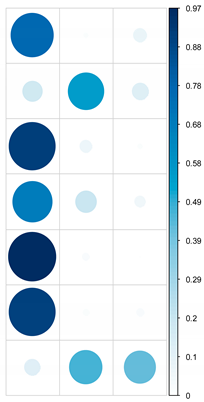 | |||
| Frequency at the maximum of loss modulus [1/s] | 33 | 92 | 32 | 56 | 48 | 143 | 121 | 61 | 36 | ||||
| Storage modulus at maximum of loss modulus [MPa] | 3.59 | 3.01 | 0.95 | 1.81 | 2.93 | 2.46 | 1.04 | 1.21 | 1.05 | ||||
| Minimum of storage modulus [MPa] | 2.36 | 2.02 | 0.80 | 1.11 | 1.89 | 1.34 | 0.60 | 0.60 | 0.51 | ||||
| Maximum of storage modulus [MPa] | 4.32 | 3.66 | 1.11 | 2.22 | 3.54 | 3.18 | 1.37 | 1.69 | 1.37 | ||||
| Height of dispersion [MPa] | 1.96 | 1.64 | 0.31 | 1.11 | 1.65 | 1.84 | 0.77 | 1.09 | 0.86 | ||||
| Width of dispersion [1/s] | 11,581 | 24,105 | 9066 | 32,749 | 29,436 | 17,8344 | 64,002 | 13,685 | 257 | ||||
| Proportion of Pixels Deviating from CAD Model | Value for Underdimensioned Pixel | Value for Overdimensioned Pixel |
| <5% | 1 | 0.1 |
| 5–10% | 2 | 0.3 |
| 10–20% | 3 | 0.5 |
| 20–40% | 4 | 0.7 |
| 40–60% | 5 | 0.9 |
| 60–80% | 6 | 1.5 |
| 80–100% | 7 | 2.5 |
| >100% | -- | 5.0 |
| Material System | Laser Power (mW) | Writing Speed (mm/s) | Energy Input (J/mm) |
| POxA1 | 400 | 7 | 57.1 |
| POxA2 | 200 | 3 | 66.7 |
| POxA3 | 400 | 3 | 133.3 |
| POxA4 | 200 | 3 | 66.7 |
| POxB1 | 100 | 1 | 100.0 |
| POxB2 | 200 | 3 | 66.7 |
| POxB3 | 100 | 3 | 33.3 |
| POxB4 | 300 | 7 | 42.9 |
| PEGDA | 400 | 5 | 80.0 |
Sample Availability: Limited amounts for analytical purposes can be obtained from the corresponding authors. |
Publisher’s Note: MDPI stays neutral with regard to jurisdictional claims in published maps and institutional affiliations. |
© 2020 by the authors. Licensee MDPI, Basel, Switzerland. This article is an open access article distributed under the terms and conditions of the Creative Commons Attribution (CC BY) license (http://creativecommons.org/licenses/by/4.0/).
Share and Cite
Czich, S.; Wloka, T.; Rothe, H.; Rost, J.; Penzold, F.; Kleinsteuber, M.; Gottschaldt, M.; Schubert, U.S.; Liefeith, K. Two-Photon Polymerized Poly(2-Ethyl-2-Oxazoline) Hydrogel 3D Microstructures with Tunable Mechanical Properties for Tissue Engineering. Molecules 2020, 25, 5066. https://doi.org/10.3390/molecules25215066
Czich S, Wloka T, Rothe H, Rost J, Penzold F, Kleinsteuber M, Gottschaldt M, Schubert US, Liefeith K. Two-Photon Polymerized Poly(2-Ethyl-2-Oxazoline) Hydrogel 3D Microstructures with Tunable Mechanical Properties for Tissue Engineering. Molecules. 2020; 25(21):5066. https://doi.org/10.3390/molecules25215066
Chicago/Turabian StyleCzich, Steffen, Thomas Wloka, Holger Rothe, Jürgen Rost, Felix Penzold, Maximilian Kleinsteuber, Michael Gottschaldt, Ulrich S. Schubert, and Klaus Liefeith. 2020. "Two-Photon Polymerized Poly(2-Ethyl-2-Oxazoline) Hydrogel 3D Microstructures with Tunable Mechanical Properties for Tissue Engineering" Molecules 25, no. 21: 5066. https://doi.org/10.3390/molecules25215066
APA StyleCzich, S., Wloka, T., Rothe, H., Rost, J., Penzold, F., Kleinsteuber, M., Gottschaldt, M., Schubert, U. S., & Liefeith, K. (2020). Two-Photon Polymerized Poly(2-Ethyl-2-Oxazoline) Hydrogel 3D Microstructures with Tunable Mechanical Properties for Tissue Engineering. Molecules, 25(21), 5066. https://doi.org/10.3390/molecules25215066







